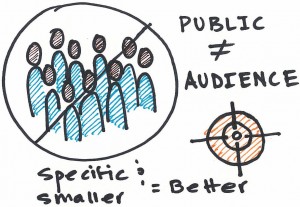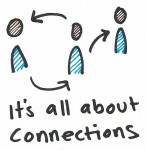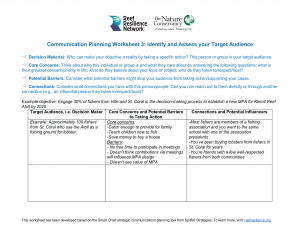Audience
Step 3: Identify Your Target Audience(s)
When developing a communication plan, the most important step after determining the goal and objectives is identifying your target audience. In order for communication to be strategic, a specific audience needs to be targeted.
Watch a short presentation about identifying your target audience:
Target Audience
The public is not a target audience
If we try to target everyone, we fail to target anyone. The smaller and more specific the target audience, the easier it is to create focused communication that will move your audience to action. Try to picture your audience and describe who they are, what they look like, and what they do. Segment your audience using categories most relevant to your work, such as demography, geography, lifestyle. Examples: urban males under 25 who own a truck; businessmen who travel frequently to Tanzania; or subsistence farmers in Palau.
Decision-makers and influencers
Your most important audience is the one who can make your goal a reality – the decision maker. This is the person whose behavior will directly impact your goal. It’s possible to reach them directly, or indirectly through the people they listen to the most – the influencers.
Focus on those you can persuade
Targeting those who oppose your goal is likely to result in frustration and failure. It’s extremely hard to change someone’s mind, but when someone is one the fence it’s possible to influence them in one direction or the other. A good first step is to identify like-minded people who are paying attention and interested in your goal. They can help influence the fence sitters who may be slightly interested or supportive but not informed, or who may not have made up their mind.
Core Concerns and Values
Learn what your audience cares about so you can show how your project relates to them
Start where your audience is. You have to meet them where they are, not where you want them to be. People care more about an issue when it’s packaged in a way that aligns with their values, concerns, and beliefs. Ask yourself what does my audience care about and value? What do they want and enjoy? People’s values come from personal experience, history, attitudes, needs, and beliefs. Shaping your strategy around your audience’s values and showing how it is connected to the things they already care about will help gain their attention and support.

Example of how people can see the same thing in different ways based on what they value (click image to enlarge).
Consider potential barriers getting in the way of your audience taking action
If your objective involves an action – and in most cases it will – than you need to identify potential barriers that may stop or delay your audience from taking action so you can overcome them. For example, if you ask someone to properly dispose of a car battery, but the desired disposal method is inconvenient for them, that is a barrier to overcome. Your job is to identify potential barriers and figure out creative ways to minimize barriers or provide incentives that make it worth it for them to take the action, even if it’s inconvenient.
How to learn about your audience
If your ‘audience’ is an individual or small group you/partners/colleagues/community contacts know well, you may be able to answer some of the questions about their core concerns and values based on your personal knowledge and basic online searches.
If your ‘audience’ is a larger or less familiar group, you can likely find existing research on characteristics such as gender, age, education level, beliefs, etc., available for free online.
Should you choose to invest in conducting new research, which can be expensive, be sure to assess research methods carefully so you choose the method(s) that will best meet your needs. In addition, consider any evaluations that will be done at the end of your process. That way, you can include questions in pre-testing that will establish a baseline for evaluation.
There are two broad categories of research – qualitative (e.g., not in numerical form) and quantitative (e.g., in numerical form). Qualitative tools, such as focus groups and interviews, can be more effective with smaller target audiences, while quantitative tools like opinion polls and phone surveys are more effective for larger audiences. For a detailed overview of qualitative and quantitative research including when to use these techniques, how they work, and potential drawbacks, see Qualitative vs. Quantitative Research Overview (pdf, 229k).
Connections
It’s all about connections
Once you’ve identified the audience you need to reach, the next step is to determine if you have any connections to them. If you are working in a small community or with a relatively small audience, you may be you reach them directly or share your messages through someone with a more direct connection to them, such as a friend, family member, acquaintance, or colleague. Your job is to identify who your audience will be most influenced by? If you are working in a larger community or city or with a larger audience, these kinds of direct connections may not apply, and you may have to recruit the media or a well-respected/celebrity messenger, which we’ll elaborate on more in the Tactics section.
Test Your Understanding
Test your understanding of the information in this section by taking the quiz.
Your Turn (> 25 minutes recommended)
Use the Audience Worksheet to write down specific audiences, their values and concerns, and your connections to them.
- Identify your decision maker(s) – individual(s) or group(s) who can make your objective a reality by taking a specific action or changing a specific behavior. (Actually write down peoples’ names if you know them.) Consider the following questions:
- Who are the people most affected by the problem and/or your project?
- Are specific groups/individuals causing the problem?
- Which audiences have the most political or social influence?
- Then think about this person or group and what they care about (their core concerns) by answering the following questions:
- What is their greatest (core) concern/priority in life?
- What do they believe about your issue/project?
- Who/what do they respect and enjoy?
- Next, consider potential barriers that might stop your audience from taking action/supporting your cause. What excuses will they have, e.g., it’s too far to drive, too expensive, not enough time? Note: list those in the same section with core concerns.
- Finally, consider what connections you have with this person/people. Will you reach out to them directly or reach them through someone else? Consider the following questions:
- What is their background?
- Who are their trusted friends, associates, family members?
- Who do they count on for advice? Who do they trust and listen to?
- If you can’t influence this person, who can?
This worksheet is based on Spitfire Strategies’ Smart Chart® strategic communications planning tool. The Smart Chart is a registered trademark of Spitfire Strategies. To learn more, visit: spitfirestrategies.com.

